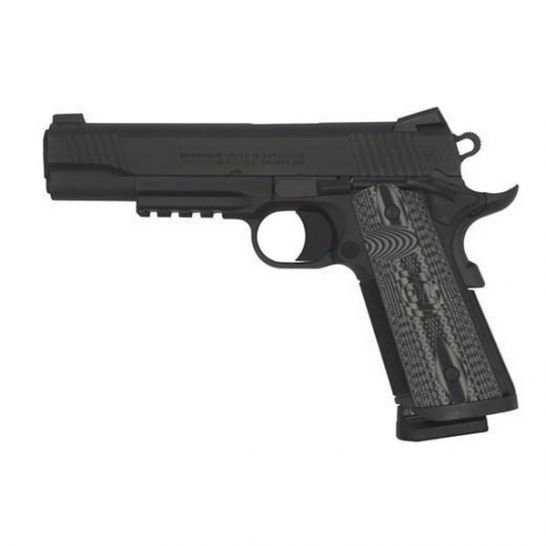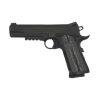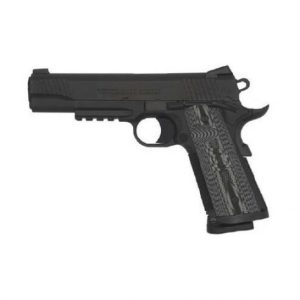Colt Combat Unit Rail Government 9mm Pistol, Black PVD – O1082RGCCU For Sale
$1,509.99
The Colt Combat Unit Rail Government 9mm Pistol, model O1082RGCCU, embodies Colt’s collaboration with US special forces trainers to deliver a firearm recognized for its superior control, accuracy, and reliability. It features a durable, matte black DLC-coated stainless steel frame for excellent corrosion resistance, suitable for everyday carry. The pistol is designed for a secure grip with custom G10 grips, 25 LPI checkering, an undercut trigger guard, and an upswept beavertail safety, all contributing to improved recoil control. Enhanced usability is provided by angled slide serrations for easy manipulation, an extended magwell for swift reloads, and Novak sights for accurate targeting. Incorporating the Series 80 firing system and a national match barrel, this model ensures safe, precise shooting. Additionally, its integrated Picatinny rail accommodates various tactical accessories, underscoring the CCU series’ versatility and readiness for duty.
What is the difference between the Colt Commander and the Colt government?
The main differences between the Colt Commander and the Colt Government Model revolve around size and design purpose:
1. **Barrel Length:**
– **Colt Government Model:** Typically has a 5-inch barrel.
– **Colt Commander:** Features a shorter barrel, usually 4.25 inches.
2. **Overall Size and Weight:**
– **Colt Government Model:** Larger and heavier due to its longer barrel and full-size frame.
– **Colt Commander:** More compact and lighter, making it easier to carry and more suitable for concealed carry.
3. **Intended Use:**
– **Colt Government Model:** Primarily designed for military use and later adapted for civilian use, it is favored for its reliability and accuracy in range shooting and duty use.
– **Colt Commander:** Developed as a more portable option for military personnel, it’s popular among civilian users for concealed carry and personal defense due to its more manageable size.
4. **Construction and Features:**
– Both models are typically similar in terms of construction materials and features, with variations available based on specific models and configurations (such as those with or without rail systems, finishes, or sights).
While both are variations of the iconic 1911 platform, each model is tailored for different preferences and practical requirements.
What is a Colt rail gun?
The Colt Rail Gun is a model of semi-automatic pistol produced by Colt’s Manufacturing Company. It is part of the M1911 series, a design originally crafted by John Browning in the early 20th century. The Colt Rail Gun is named for its accessory rail, which allows users to attach tactical components like lights or lasers. Known for its reliability, accuracy, and classic design, the Colt Rail Gun is popular among law enforcement, military personnel, and civilian gun enthusiasts.
What caliber is the Colt government?
The Colt Government, also known as the Colt M1911, is traditionally chambered in .45 ACP (Automatic Colt Pistol). However, there are also variants chambered in other calibers such as 9mm and .38 Super.
Do Colt 1911 hold their value?
Yes, Colt 1911 pistols generally hold their value well. Due to their historical significance, iconic design, and reputation for reliability and performance, they are often sought after by collectors and firearms enthusiasts. Limited editions, rare models, and those in excellent condition can even appreciate over time.
What is the most powerful Colt?
The most powerful Colt firearm is typically considered the Colt M1911 chambered in .45 ACP, known for its stopping power and historical significance. However, in terms of sheer power, the Colt Anaconda, a large frame revolver chambered in .44 Magnum, is often regarded as more powerful due to the larger and more potent cartridge.
What does the AR stand for in Colt?
In Colt firearms, “AR” stands for “Automatic Rifle.”
Is it illegal to own a rail gun?
The legality of owning a railgun typically depends on the laws and regulations of the country or region in question. In the United States, private ownership of railguns is not explicitly illegal, as they do not fall under the same regulatory framework as firearms. However, there are restrictions on their use and the possession of related components. Additionally, railguns may be subject to state and local laws that impose further restrictions. Always check and comply with the specific laws applicable to your area regarding the ownership and use of such devices.
Has a rail gun ever been used in combat?
As of my last update, a rail gun has not been used in combat. Rail guns remain primarily in the development and testing stages within military research.
What is the difference between a rail gun and a regular gun?
A rail gun and a regular gun differ primarily in their method of propulsion.
1. **Propulsion Mechanism**:
– **Rail Gun**: Uses electromagnetic force to launch projectiles. It consists of two parallel conducting rails and a projectile that bridges the gap between them. When a strong electric current flows through the rails, a magnetic field is generated, propelling the projectile at high speeds.
– **Regular Gun**: Uses chemical propulsion to launch projectiles. It involves an explosive chemical reaction (like gunpowder igniting) to generate high-pressure gas, pushing the bullet down the barrel.
2. **Projectile Speed**:
– **Rail Gun**: Can achieve much higher velocities due to the lack of chemical propellants and the direct application of electromagnetic force.
– **Regular Gun**: Generally limited by the chemical energy of the gunpowder, resulting in lower projectile velocities compared to rail guns.
3. **Energy Source**:
– **Rail Gun**: Requires a substantial amount of electrical energy and advanced power systems to operate.
– **Regular Gun**: Relies on compact chemical energy stored in the form of ammunition (gunpowder).
4. **Wear and Tear**:
– **Rail Gun**: The intense electromagnetic forces and friction can cause significant wear on the rails, which may require frequent maintenance.
– **Regular Gun**: Experiences wear from heat and friction, but generally less severe than in rail guns.
5. **Use and Applications**:
– **Rail Gun**: Primarily researched and developed for military applications; experimental at this stage with potential for long-range artillery.
– **Regular Gun**: Widely used for military, law enforcement, hunting, and personal defense.
These key differences influence their operation, maintenance, and applications.
Is a 38 super stronger than a 9mm?
The .38 Super is generally more powerful than the 9mm Parabellum (9x19mm) in terms of velocity and energy. Originally designed for higher pressures, the .38 Super typically fires a bullet at a higher velocity, which can result in greater muzzle energy compared to most standard 9mm rounds. However, advancements in 9mm ammunition have led to high-performance loads that can narrow this gap. Ultimately, the “strength” depends on the specific ammunition being compared and the intended use, as factors like penetration, recoil, and overpenetration must also be considered.
What gun did Wyatt Earp use?
Wyatt Earp is historically known to have used a Colt Single Action Army revolver. However, specifics about his guns can be somewhat uncertain due to varying accounts and the lapse of time. This type of revolver was commonly used during that era, and it’s often associated with Earp and the gunfight at the O.K. Corral.
What is the price of Colt Government 1911 A1?
I don’t have real-time pricing data, so I suggest checking the latest prices for a Colt Government 1911 A1 through a trusted firearms retailer, online marketplace, or local gun store website. Prices can vary based on factors such as location, condition, and availability.
What rank was Commander Colt?
Commander Colt held the rank of Clone ARC Commander in the Grand Army of the Republic.
What is the difference between a commander and an officer?
The primary difference between a commander and an officer lies in their roles and ranks within the military hierarchy:
1. **Officer**: An officer is a general term for a member of the military who holds a position of authority and may have various ranks ranging from junior to senior levels. Officers are responsible for leading and managing enlisted personnel, making strategic decisions, and ensuring the successful completion of missions. Officers can hold ranks such as Lieutenant, Captain, Major, and Colonel, among others.
2. **Commander**: The term “commander” can refer to a specific rank in some naval and air forces, such as a “Commander” in the Navy, which is above Lieutenant Commander and below Captain. However, “commander” is also a general term for someone who holds a command position, meaning they are in charge of a particular unit or group of personnel, regardless of their specific rank. In this sense, a commander can be an officer but not all officers are commanders.
In summary, while all commanders are officers, not all officers are commanders. A commander is typically in charge of a specific unit or operation, whereas an officer is anyone who holds a rank and a leadership role in the military.
How many rounds does a Colt 1911 commander hold?
A Colt 1911 Commander typically holds 7 rounds in the magazine, plus one in the chamber, making a total of 8 rounds. However, some models and aftermarket magazines may have a different capacity.
| Product Line | Combat Unit Rail Government |
|---|---|
| Action | Single |
| Sights | Novak Front and Rear |
| Slide | Black PVD Stainless Steel |
| Safety | Ambidextrous Extended Thumb |
| Grips | Gray G10 Checkered with Scallop |
| Frame Material | Stainless Steel |
| Frame Finish | Black PVD |
| Overall Length | 8-1/2" |
Be the first to review “Colt Combat Unit Rail Government 9mm Pistol, Black PVD – O1082RGCCU” Cancel reply
Related products
Colt Combat Unit Rail Government
Colt Combat Unit Rail Government .45 ACP Pistol, Black PVD – O1080RGCCU



Reviews
There are no reviews yet.